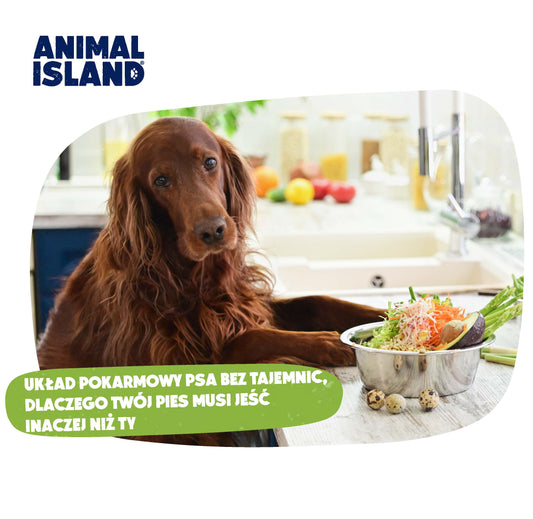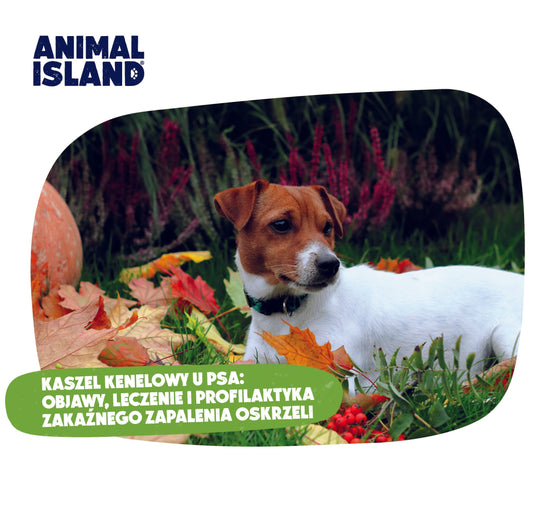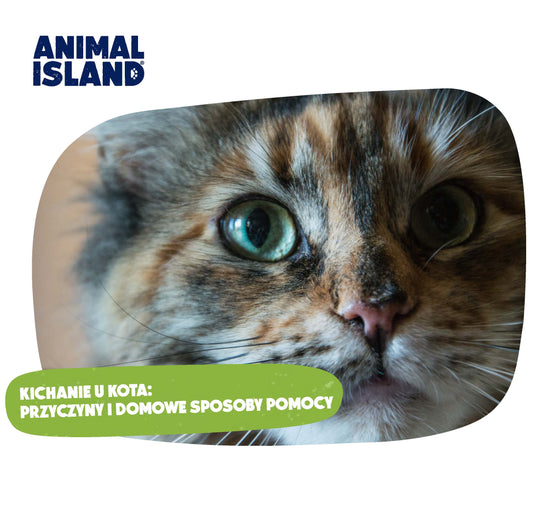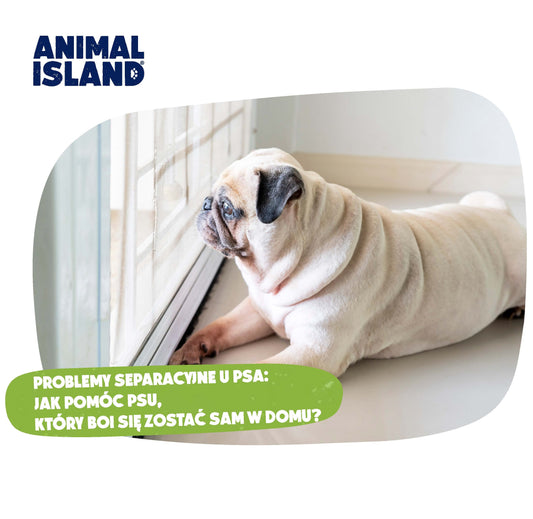How to read dog food labels and what ingredients to avoid?

Reading dog food labels can initially feel like deciphering a code. It's easy to get lost in the maze of unfamiliar ingredients and names. However, as conscious caregivers, we must remember to provide our dogs with high-quality meals. Therefore, skillfully selecting the right and valuable ingredients is key to your pet's health, energy, and long life.
In this article, we will tell you how to effectively read dog food labels and which ingredients should make you alert.
Did you know that…
If you notice your dog eating grass, it may be a sign that their diet is lacking nutrients. This is your pet's way of trying to make up for the deficiencies in their food, especially if they are lacking fiber. Grass contains fiber, which can aid in digestive processes. If you see this behavior in your dog, be sure to check the ingredients of the meals they are currently serving.
KEEP YOUR NOSE IN YOUR KARMA
Choose consciously: Wondering why reading the food label is important? You are in charge here, so use that power for the good of your pet. Everything we eat affects our health and well-being, and it is the same with your dog. Conscious nutrition means avoiding harmful ingredients and choosing healthy and nutritious food. Unfortunately, many attractive advertisements offer only pretty packaging, the composition of such products leaves much to be desired…
Differences in the quality of food: There are foods available on the market with very different compositions. Two foods for similar purposes can differ dramatically: one will contain 70% meat, and another will mainly contain grains and artificial additives. Only a careful analysis of the label will allow you to see these differences.
Harmful ingredients: For the health and safety of your dog, you need to know that many health problems, such as allergies, obesity or digestive problems, result from an improper diet. Careful analysis and elimination of specific, harmful ingredients, such as preservatives, allows for healthy dog management. Therefore, reading the composition of the food will allow you to eliminate harmful ingredients from the diet and thus, can prevent many unwanted reactions of the body.
FIRST STEPS IN UNDERSTANDING INGREDIENTS ON LABELS
INGREDIENTS LIST
Dog food manufacturers are required to provide detailed information on their product labels. They should list the ingredients in descending order by weight, meaning that the ingredient with the largest weight share in the product must be used first, and the ingredient with the smallest weight share is used last. This rule helps owners to understand the quality of the food. How does it work in practice? We are here to help. Since the first items on the list are the basis of the food, it is ideal if meat (e.g. fresh chicken, lamb, etc.) is listed first, which indicates a high content of animal protein. If we see grains in the first place, this is an alarm signal. Grains are often used as cheap fillers in food, which can result in the dog's diet containing fewer high-quality ingredients.
NOTHING TO HIDE – IT'S A MATTER OF HEALTH AND LIFE
If the food manufacturer has nothing to hide, you will find a detailed description of the ingredients on the label. A precisely written composition includes information about the percentage of a specific ingredient, e.g. "dried chicken meat 30%". A transparent composition indicates the manufacturer's confidence in the quality of the ingredients used. The abbreviated description "poultry 30%" indicates an attempt to hide precise information about the product. Therefore, be careful and avoid products containing ambiguous terms, such as "animal by-products" without specifying which raw materials are meant.
ANALYTICAL COMPOSITION UNDER THE GLASS
Guaranteed analysis refers to information about the ingredients listed on the label. In addition to the list of ingredients, you will also find the percentage of protein, fat, fiber and ash. This allows you to assess the nutritional value of the food yourself. A good food should have a high level of animal protein and moderate fat, depending on the dog's needs - the needs of puppies, active dogs or seniors will be completely different.
Also pay attention to the origin of the ingredients. The best quality is characterized by protein from raw or cooked meat and animal organs. Plant products have less protein than animal products.
ADDITIONS FOR A PLUS OR A MINUS
In addition to the basic nutrients, dog food labels often also include information about additional ingredients, which are divided into technological and dietary additives.
Technological additives are substances that are intended to improve the physical properties of food, its durability or taste. Examples of such additives include antioxidants, which protect the fats contained in the food from becoming rancid, as well as stabilizers and preservatives. There are both natural and artificial antioxidants and preservatives, and their presence in food is of significant importance for the animal's health.
Natural antioxidants: One of the most popular natural antioxidants used in dog food is vitamin E, often found in the form of mixed tocopherols. Tocopherols are effective in delaying the oxidation of fats, which helps maintain the quality of the food for a longer period of time. Other natural antioxidants include vitamin C and plant extracts such as rosemary, which also have preservative properties.
By choosing products with natural preservatives, we can contribute to a healthier diet for our pet. Natural preservatives are often seen as safer alternatives and can support the long-term well-being of the animal.
Artificial antioxidants: Artificial antioxidants include substances such as BHA (butylhydroxyanisole) and BHT (butylhydroxytoluene). Although they are effective in extending the shelf life of pet food, their use is controversial. There are concerns about their potential health effects, as some studies suggest they may be associated with health problems with long-term consumption in both humans and animals. As a result, many experts recommend avoiding pet foods that contain these artificial additives.
Dietary supplements are ingredients that are intended to enrich a dog's diet with specific, beneficial substances. These most often include various vitamins and minerals that support the health of the quadruped. For example, vitamin A affects the health of the eyes and skin, vitamin D3 supports the health of bones and teeth by regulating the calcium-phosphate metabolism, and vitamin E acts as an antioxidant, protecting cells from damage. Zinc is essential for healthy skin and fur and supports the functioning of the immune system.
With these additives, dog food can be better tailored to specific health needs, helping to maintain the animal's overall condition. The manufacturer should provide information on the amount and type of additives so that caregivers can make informed choices about the right product.
WARNING! AVOID THESE INGREDIENTS!
· Artificial preservatives
It's unbelievable what ingredients are added to some dog foods. You need to know that the above-described BHA (E320), BHT (E321) and ethoxyquin are synthetic substances used in dog foods that can cause allergies, stomach problems and even cancerous changes.
BHA (Butylhydroxyanisole) (E320): BHA is an antioxidant that some studies suggest may cause a variety of health problems. Its presence in the diet may be linked to allergies in pets, as well as digestive problems such as stomach upset. High doses of BHA have been the subject of studies on their potential carcinogenic effects, which has raised concerns and caused some experts and caregivers to try to avoid pet foods containing this ingredient.
BHT (Butylhydroxytoluene) (E321): Like BHA, BHT is a synthetic antioxidant used in dog food to prevent fat oxidation. However, as with BHA, there is controversy about the safety of BHT. Some studies suggest that long-term consumption can lead to health problems such as allergic reactions, stomach problems, and, in some contexts, an increased risk of cancerous changes.
Ethoxyquin: Ethoxyquin is another synthetic preservative used in some dog foods. There are concerns about its effects on pets’ health. Potential side effects can include allergic reactions, digestive problems, and even an increased risk of cancer with long-term use.
Because of these concerns, veterinarians and informed caregivers often recommend choosing foods that do not contain these synthetic additives. Instead, look for products preserved with natural antioxidants, such as tocopherols (vitamin E) or plant extracts. Choosing a food without controversial additives can contribute to the long-term health and well-being of your dog.
· Artificial dyes
On the packaging labels you will also find additives such as: Red 40, Yellow 5 and Blue 2 are artificial colors commonly used in the food industry, including in the production of pet food. Their primary purpose is to give the product an aesthetic appearance that is supposed to attract your attention. However, for a healthy diet of a dog, these colors are completely unnecessary.
Red 40: Also known as Allura Red, this is one of the most commonly used artificial colors. Despite its popularity, it provides no nutritional or functional value to your dog. There are also concerns about its potential health effects, such as allergic reactions, although the evidence is mixed and still being studied.
Yellow 5: Also known as Tartrazine, this dye is often used to give products a yellow color. Like other artificial colors, it may be associated with allergies or sensitivities in some animals. From the perspective of dogs, who judge food primarily by smell, the color of the food does not matter, so its addition is only for the aesthetics of the product from a human perspective.
Blue 2: This dye is used to give a blue tint to products. It is also completely unnecessary for the dog and its health. Such dyes can only be an unnecessary additional burden for the body with long-term consumption.
Generally, dyes like these do not affect the taste, smell, or nutritional value of the food, making them an unnecessary addition from a health perspective. For owners looking for the best nutritional option for their pets, it is worth considering choosing products that do not contain artificial dyes. A natural appearance of the food without bright colors is often a sign that the product is less processed and free of unnecessary additives.
· Excess grains and fillers
When choosing a dog food, pay attention to the ingredients and avoid those that rely heavily on grains as their main source of calories. Grains commonly used in dog food, such as corn and wheat, are not toxic in and of themselves, but excessive amounts of them in the food can affect its quality and nutritional value. Yes, dogs can digest grains, but sweet potatoes are a much better choice than wheat. Grains are often used as fillers in commercial pet foods. Their main ingredient is starch, which provides an easy source of energy. However, for dogs, which are mostly carnivores, the digestibility and benefits of digesting large amounts of grain carbohydrates are limited.
Some dogs may have difficulty digesting grains, leading to stomach issues such as bloating, diarrhea, and indigestion. Additionally, grains such as corn and wheat can cause food allergies in some dogs. Symptoms of intolerance or allergy can include itching, scratching, skin lesions, and even chronic ear and digestive problems.
- · Unspecified “by-products”
Terms like “meat meal” and “animal products” on dog food labels can be a cause for concern, as they are quite general and imprecise, which can hide low-quality ingredients. We warn you that knowing what these terms mean may give you goosebumps…
Meat Meal: Meat meal is a powdered product that is made from animal waste processed in a mill. While meat meal can be a source of protein, the quality of that protein depends largely on the raw materials from which it is produced. Meat meal often contains waste that is not used for human consumption, such as feathers, claws, hooves, skin, or even entrails. These ingredients are considered low biological value protein sources, meaning they can be more difficult for your dog to digest and provide fewer essential amino acids.
Animal products: This very general term includes all parts of the animal that are not specified. It can include both high-quality and low-quality ingredients. The lack of clarity about the type of meat and its source is often used by manufacturers to hide cheaper, lower-quality substitutes.
- · Sugar in dog food
Sugar is not a natural part of a dog's diet, which should be based on animal proteins and fats. Manufacturers add sugar or its derivatives, such as glucose syrup or sucrose, mainly to mask low-quality ingredients or to give products a more attractive taste, which is to attract both dogs and their owners. Due to the sweet taste, dogs may be more willing to reach for such products, but this is detrimental to their health.
The saying "all that glitters is not gold" applies here, because Caramel, used as a coloring, gives products an aesthetic color, which is supposed to increase their visual appeal. However, the color of the food is not important to dogs, who evaluate food mainly by smell, not sight.
Dangers of excess sugar:
- Obesity: Excess sugar in a dog's diet leads to a calorie surplus, which promotes weight gain and obesity. Obesity is a serious health problem that can strain the circulatory system, joints, and reduce the overall quality of life of a dog.
- Dental disease: Sugars contribute to the build-up of bacterial plaque on teeth, which can lead to tooth decay, gum disease and bad breath.
- Diabetes Risk: Long-term consumption of sugars may increase the risk of developing type 2 diabetes in dogs, a problem that requires intensive veterinary care and can drastically affect your pet's quality of life.
For the sake of your pet's health, avoid foods and treats containing sugar, glucose syrup, sucrose and other sweeteners. Instead, choose products with natural ingredients of high nutritional value that meet the dog's needs without unnecessary sugar additives. It is worth playing Sherlock Holmes to provide your pet with a high standard of living.
- · Artificial flavors and flavor enhancers
Artificial flavors, like colorants, are commonly used in dog foods to enhance the appeal of products, both in terms of smell and taste. However, these types of additives are not necessary in the diet of our four-legged friends and can lead to undesirable health consequences.
Flavors such as "nature identical" or monosodium glutamate (MSG) are added to enhance or improve the taste of food. Their purpose is often to mask the poor quality of the ingredients in the product. These additives can make dog food seem more appetizing, which is supposed to encourage dogs to eat it, even though it has low nutritional value.
Monosodium glutamate (MSG) is a flavor enhancer that can intensify umami, or the taste of meat. Their addition makes food more appealing, which can lead to dogs eating more than necessary. In dogs, as in humans, long-term exposure to MSG is being studied for its possible health effects, although there is currently no clear scientific evidence in animals that it has a direct harmful effect.
Risks of using artificial flavors:
- Masking quality: Artificial flavors can mask the lower quality of ingredients used in the production of the food. This can mislead the dog owner as to the actual nutritional value and quality of the product.
- Encouraging overeating: Strong aromas can encourage dogs to eat larger amounts of food, which in the long term can lead to overweight and obesity.
- Potential allergic reactions: Although rare, some animals may be sensitive to artificial additives, which may cause allergic reactions or intolerances.
- · Propylene glycol
It works pretty much as it sounds… If you read the label and see “propylene glycol” in the ingredients, put the product back on the shelf. Propylene glycol acts as a humectant, meaning it absorbs and retains moisture. This makes foods and treats more appealing in terms of texture – soft and easy for dogs to chew. This is especially important for semi-moist products, which otherwise could lose moisture and become brittle. However, the use of propylene glycol in dog foods is controversial due to its potential health effects:
Intestinal Issues: In some dogs, consuming products containing propylene glycol may lead to digestive issues such as diarrhea or flatulence.
Red blood cell damage: There are concerns that propylene glycol may contribute to red blood cell damage in animals, particularly cats, although this is less of a concern in dogs due to their slightly different biological response.
FRAUD! MELAMINE ADDED TO FOOD
Melamine is an organic chemical compound that has caused much controversy in the production of pet food. A few years ago, there was a scandal involving the addition of melamine to dog and other animal food. The purpose of this procedure was to artificially increase the level of protein available in the products and to obtain better quality test results.
This practice has had dramatic consequences for animal health. Melamine is a toxic substance, and its presence in feed has been linked to food poisoning and problems with heart and kidney failure.
In response to these events, stricter standards for pet food production were introduced, prohibiting the use of melamine as an ingredient in pet food. The presence of melamine in pet food is now considered a violation of regulations and fraud on the part of the manufacturer.
GOLDEN RULES - here's what to pay attention to when choosing dog food:
A LOT OF MEAT
Dogs are carnivores, which means that their bodies are adapted to large amounts of animal products. The ideal food for your pet has meat or fish as its first ingredient. The composition of the food should contain precise information about the type of meat, which is listed first in the description. This is the first good sign that we are on the trail of good food. For example, the Animal Island food " Venison with potatoes" contains as much as 86% of wild boar meat in the composition.
NATURAL PRESERVATIVES AND ADDITIVES
Look for information about natural antioxidants (e.g. vitamin E, rosemary extract) in the composition instead of the above-mentioned BHA/BHT. Good foods often boast on the label about the lack of artificial additives - e.g. the slogan "no preservatives, no dyes". Animal Island foods are preserved exclusively by natural methods and do not contain artificial preservatives or added sugar!
SHORT AND TO THE POINT
A short list of ingredients indicates the content of specific ingredients, is clear and legible. Of course, the food must be balanced, so a certain number of ingredients are needed, but pay attention to whether most of them are nutritional components (meat, vegetables, oils, vitamins) and not fillers. Avoid food where the list of ingredients is very long and full of difficult chemical names. It is better to choose one whose composition sounds like a recipe for a meal - e.g. "chicken, pumpkin, salmon oil, carrots, rice, linseed..."
HUMAN GRADE DECLARATION
These days, more and more people are paying attention to the quality of the products they eat, as well as what they give to their pets. One term that has gained popularity is "human grade" or food grade. But what does that actually mean?
The "human grade" claim refers to products that meet the quality and safety standards required for food intended for human consumption. This is important in the context of dog food because it means that the ingredients used to make these foods are of such high quality that they could be consumed by humans.
In practice, this means that every ingredient that goes into a product marked as "human grade" has undergone rigorous quality tests, and the entire production process takes place in plants certified for the production of human food. This ensures that the product is free from harmful substances such as pesticides, antibiotics or hormones.
Why does it matter? When it comes to your dog's diet, choosing products labeled "human grade" can have many benefits. First of all, such foods are usually more nutritious and easier to digest, which can lead to improved health and fitness. Plus, you can be sure that you are feeding your pets the highest quality products that are safe and healthy.
Of course, it is worth remembering that not all products labeled "human grade" are created equal. It is important to read labels carefully and choose those that actually meet certain standards. It is also worth paying attention to certificates and accreditations that can confirm the quality and safety of the products.
FUNCTIONAL INGREDIENTS
These days, it's not just about meeting basic nutritional needs, but also about supporting the health and well-being of our pets. That's why it's worth paying attention to functional ingredients in food that can bring many health benefits.
One such ingredient is salmon oil, which is a rich source of omega-3 fatty acids. These valuable fats are not only beneficial for the health of your dog's coat, but they also support the immune system and can have anti-inflammatory effects. Regular consumption of omega-3 fatty acids can keep your dog's coat shiny and healthy.
Another important functional ingredient is glucosamine and chondroitin. These compounds are especially important for older dogs and those with joint problems. Glucosamine supports the regeneration of joint cartilage, and chondroitin protects it from damage. Thanks to this, dogs can enjoy greater freedom of movement and less joint pain.
Probiotics are another additive worth considering. They aid digestion and improve the health of your dog's gut. With probiotics, the bacterial flora in your dog's gut can be in better shape, which translates into better nutrient absorption and overall improved health.
Cranberries are an ingredient that is gaining popularity in dog food. They are known for their urinary tract prophylaxis properties. Regular consumption of cranberries can help prevent urinary tract infections, which is especially important for dogs that are prone to these types of problems.
Food manufacturers often emphasize the presence of these ingredients on labels or in additive tables. That is why it is worth reading the information on the packaging carefully and choosing products that offer added value in the form of functional ingredients. This is an investment in the health and well-being of our pet.
Ingredients functional ingredients in dog food are not just a fad, but a real value that can bring many health benefits.
SUMMARY
When we stand in front of a store shelf full of colorful food packages, it is easy to be tempted to buy a product that catches the eye. However, the appearance of the package does not always match the quality of the contents. Analyzing the label allows us to find out what is actually in the food and whether it is suitable for our dog.
Since Animal Island’s mission is to improve the lives of dogs and cats, we hope this article will be useful to you and many other loving Guardians. The most important message on this topic – read labels and choose wisely!
Awareness is the key to a dog's health: In summary, when choosing food for your dog, it is worth being guided by the transparency of information on the label and choosing products with clearly specified ingredients, which is often a sign of better quality and nutritional value of the food. Spend a few minutes analyzing the label before buying the food. Avoid the listed harmful additives (BHA, dyes, sugar, etc.), look for food rich in meat, free of artificial chemicals.
Trusted manufacturers: Trusted pet food manufacturers are those who care about the quality of their products and openly inform about their ingredients. There are many reputable brands on the market that have gained recognition among both experts and pet owners. When choosing food for your pet, it is worth paying attention to the opinions of other users and recommendations from specialists.
Taking care of the diet is an investment: High-quality food may be more expensive, but it usually translates into better health for your pet. By choosing high-quality food, we ensure our dog's health, energy and long, happy life. By reading labels and choosing products consciously, we can be sure that we are giving our pet the best.
FIND OUT MORE
When choosing dog food, it is crucial to understand what is really in the package. A good quality dog food should contain high-quality animal protein, such as meat, which provides essential amino acids. Additionally, valuable additives such as vegetables, herbs, and omega-3 oils support healthy skin and coat, as well as improve joint function. If you want to learn more about what ingredients should be in the perfect dog food for your dog, read our article on the key ingredients of the right dog food, available on our blog: bit.ly/3ZSoHng .
“Treat your dog well and he will reward you for it.
He will keep you company,
will be your best friend and will never question you.”
Mary Schaffe


 Wścieklizna
Wścieklizna



 Zęby i jama ustna – stworzone do chwytania, nie mielenia
Zęby i jama ustna – stworzone do chwytania, nie mielenia




 ROZSĄDNA DIETA, BY ZAPOBIEGAĆ BIEGUNCE W PRZYSZŁOŚCI
ROZSĄDNA DIETA, BY ZAPOBIEGAĆ BIEGUNCE W PRZYSZŁOŚCI








